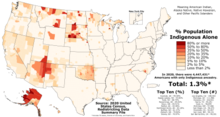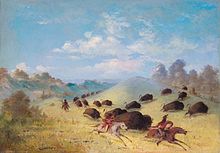 Global Information
Global InformationNative Americans in the United States information
This article may be too long to read and navigate comfortably. When this tag was added, its readable prose size was 21,000 words. (March 2024) |
 Proportion of Indigenous Americans in each of the 50 states, Washington, D.C., and Puerto Rico as of the 2020 census | |
| Total population | |
|---|---|
| American Indian and Alaska Native (2020 census)[1][2] One race: 3,727,135 are registered In combination with one or more of the other races listed: 5,938,923 Total: 9,666,058 ~ 2.9% of the total U.S. population. | |
| Regions with significant populations | |
| Predominantly in the Western and Midwestern United States | |
| Languages | |
| English Native American languages (including Navajo, Central Alaskan Yup'ik, Tlingit, Haida, Dakota, Seneca, Lakota, Western Apache, Keres, Cherokee, Choctaw, Creek, Kiowa, Comanche, Osage, Zuni, Pawnee, Shawnee, Winnebago, Ojibwe, Cree, O'odham[3]) Spanish Native Pidgin (extinct) French | |
| Religion | |
| |
| Related ethnic groups | |
|
| Part of a series on |
| Native Americans in the United States |
|---|

Native Americans, sometimes called American Indians, First Americans, or Indigenous Americans, are the Indigenous peoples of the United States or portions thereof, such as American Indians from the contiguous United States and Alaska Natives. The United States Census Bureau defines Native American as "all people indigenous to the United States and its territories, including Native Hawaiian and Other Pacific Islanders, whose data are published separately from American Indians and Alaska Natives".[4] The U.S. census tracks data from American Indians and Alaska Native separately from Native Hawaiian and other Pacific Islanders,[4] who include Samoan Americans and Chamorros.
The European colonization of the Americas that began in 1492 resulted in a precipitous decline in the size of the Native American population because of newly introduced diseases, including weaponized diseases and biological warfare by European colonizers,[5][6][7][8][9] wars, ethnic cleansing, and enslavement. Numerous historians have called this event a genocide. White settlers, as part of a policy of settler colonialism, continued to wage war and perpetrated massacres against Native American peoples, removed them from their ancestral lands, and subjected them to one-sided government treaties and discriminatory government policies. Into the 20th century, these later policies focused on forced assimilation.[10][11][12]
When the United States was established, Native American tribes were generally considered semi-independent nations, because they generally lived in communities which were separate from communities of white settlers. The federal government signed treaties at a government-to-government level until the Indian Appropriations Act of 1871 ended recognition of independent Native nations, and started treating them as "domestic dependent nations" subject to applicable federal laws. This law did preserve the rights and privileges agreed to under the treaties, including a large degree of tribal sovereignty. For this reason, many Native American reservations are still independent of state law and the actions of tribal citizens on these reservations are subject only to tribal courts and federal law, often differently applicable to tribal lands than to U.S. state or territory by exemption, exclusion, treaty, or superseding tribal or federal law.
The Indian Citizenship Act of 1924 granted U.S. citizenship to all Native Americans born in the United States who had not yet obtained it. This emptied the "Indians not taxed" category established by the United States Constitution, allowed Natives to vote in state and federal elections, and extended the Fourteenth Amendment protections granted to people "subject to the jurisdiction" of the United States. However, some states continued to deny Native Americans voting rights for several decades. Titles II through VII of the Civil Rights Act of 1968 comprise the Indian Civil Rights Act, which applies to the Native American tribes of the United States and makes many but not all of the guarantees of the U.S. Bill of Rights applicable within the tribes (that Act appears today in Title 25, sections 1301 to 1303 of the United States Code).[13]
Since the 1960s, Native American self-determination movements have resulted in positive changes to the lives of many Native Americans, though there are still many contemporary issues faced by them. Today, there are over five million Native Americans in the United States, 78% of whom live outside reservations. The states with the highest percentage of Native Americans in the U.S. are Alaska, Oklahoma, New Mexico, South Dakota, Montana, and North Dakota.[14][15]
- ^ "Overview of 2020 AIAN Redistricting Data: 2020" (PDF). Archived from the original (PDF) on January 26, 2022. Retrieved January 16, 2022.
- ^ "Race and Ethnicity in the United States: 2010 Census and 2020 Census". Retrieved January 16, 2022.
- ^ Siebens, J & T Julian. Native North American Languages Spoken at Home in the United States and Puerto Rico: 2006–2010. United States Census Bureau. December 2011.
- ^ a b "U.S. Census Bureau History: American Indians and Alaska Natives". U.S. Census Bureau. Retrieved July 30, 2023.
- ^ Alibek, Ken (2004). "Smallpox: a disease and a weapon". International Journal of Infectious Diseases. 8. Elsevier BV: 3–8. doi:10.1016/j.ijid.2004.09.004. ISSN 1201-9712. PMID 15491869.
- ^ Colonial Williamsburg, CW Journal, Spring 2004, "Colonial Germ Warfare"
- ^ Fenn, Elizabeth A. (2001). Pox Americana: The Great Smallpox Epidemic of 1775–82 (1st ed.). Hill and Wang. pp. 88–89, 275–276. ISBN 080907821X.
- ^ Fenn, Elizabeth A (March 2000). "Biological Warfare in Eighteenth-Century North America: Beyond Jeffrey Amherst". Journal of American History. 86 (4): 1553. doi:10.2307/2567577. JSTOR 2567577.
- ^ Robertson, Roland G. (2001). Rotting Face: Smallpox and the American Indian (1st ed.). University of Nebraska Press. pp. 119, 124. ISBN 0870044192.
- ^ Wolfe, Patrick (December 1, 2006). "Settler colonialism and the elimination of the native". Journal of Genocide Research. 8 (4): 387–409. doi:10.1080/14623520601056240. ISSN 1462-3528. S2CID 143873621.
- ^ Hixson, W. (December 5, 2013). American Settler Colonialism: A History. Springer. ISBN 978-1-137-37426-4 – via Google Books.
- ^ Whitt, Laurelyn; Clarke, Alan W. (2019). North American Genocides: Indigenous Nations, Settler Colonialism, and International Law. Cambridge University Press. ISBN 978-1-108-42550-6 – via Google Books.
- ^ ""Civil Rights Act of 1968" full text" (PDF). U.S. Government Publishing Office. November 14, 2018. Archived (PDF) from the original on May 8, 2020. Retrieved May 8, 2020.
- ^ "Race and Ethnicity in the United States: 2010 Census and 2020 Census". census.gov. United States Census Bureau. Retrieved August 15, 2021.
- ^ "2020 Census: Native population increased by 86.5 percent". Ict News. August 13, 2021. Retrieved November 24, 2022.